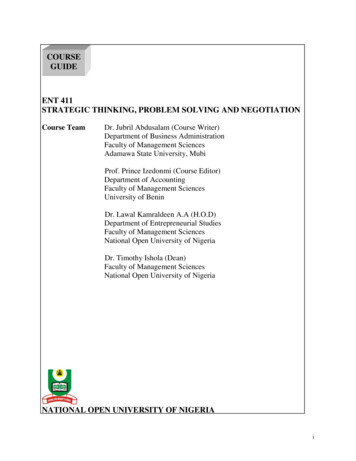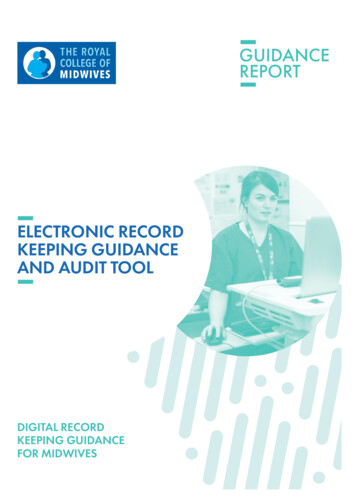
Transcription
Cover.qxd5/24/20227:09 AMPage 1GuidanceAccounting and ReportingFinancial Reporting CouncilJune 2022Guidance on the Strategic ReportFinancial Reporting Council8th Floor125 London WallLondonEC2Y 5AS 44 (0)20 7492 2300www.frc.org.uk
Cover.qxd5/17/20229:31 AMPage 2The FRC’s purpose is to serve the public interest by setting highstandards of corporate governance, reporting and audit and by holdingto account those responsible for delivering them. The FRC sets theUK Corporate Governance and Stewardship Codes and UK standardsfor accounting and actuarial work; monitors and takes action to promotethe quality of corporate reporting; and operates independent enforcementarrangements for accountants and actuaries. As the Competent Authorityfor audit in the UK the FRC sets auditing and ethical standards andmonitors and enforces audit quality.The FRC does not accept any liability to any party for any loss, damage orcosts howsoever arising, whether directly or indirectly, whether in contract,tort or otherwise from any action or decision taken (or not taken) as a resultof any person relying on or otherwise using this document or arising fromany omission from it. The Financial Reporting Council Limited 2022The Financial Reporting Council Limited is a company limited by guarantee.Registered in England number 2486368. Registered Office:8th Floor, 125 London Wall, London EC2Y 5AS
Financial Reporting CouncilJune 2022Guidance on the Strategic Report
ContentsPageGuidance on the Strategic ReportSummary31Objectives and how to use this Guidance62Scope83The annual report114The strategic report: purpose175The strategic report: materiality196The strategic report: communication principles227The strategic report: content elements257AThe strategic report: content elements for entities that are not PIEs or arePIEs with 500 or fewer employees277BThe strategic report: content elements for entities that are PIEs with morethan 500 employees427CThe strategic report: climate-related financial disclosures598The strategic report: content elements for the section 172 reporting619The strategic report with supplementary material67AppendicesIGlossary69IIThe Companies Act 2006 strategic report disclosure requirements73IIIThe Companies Act 2006 directors’ report disclosure requirements88IV(a) The Companies Act 2006 strategic report disclosure requirements as theyapply to LLPs98IV(b) The Companies Act 2006 energy and carbon report disclosure requirementsfor large LLPs106Basis for Conclusions109Financial Reporting Council1
2Guidance on the Strategic Report (June 2022)
Summary(i)The Financial Reporting Council’s (FRC’s) purpose is to serve the public interest bysetting high standards of corporate governance, reporting and audit and by holding toaccount those responsible for delivering them. The FRC believes that encouragingentities1 to prepare a high quality strategic report – which provides shareholders with aholistic and meaningful picture of an entity’s business model, strategy, development,performance, position and future prospects – is a key part of achieving this purpose.(ii)The FRC believes the strategic report should be clear and concise and result in fair,balanced and understandable reporting. The Guidance on the Strategic Report (theGuidance) is therefore intended to encourage preparers to consider how the strategicreport fits within the annual report as a whole with a view to improving the overall quality ofcorporate reporting.(iii) This Guidance relates to the Companies Act 2006 requirement to prepare a strategicreport, which was brought in through the following regulations:(a) The Companies Act 2006 (Strategic Report and Directors’ Report) Regulations 2013(SI 2013/1970);(b) The Companies, Partnerships and Groups (Accounts and Non-Financial Reporting)Regulations 2016 (SI 2016/1245);(c)The Companies (Miscellaneous Reporting) Regulations 2018 (SI 2018/860);(d) The Statutory Auditors Regulations 2017 (SI 2017/1164); and(e) The Companies (Strategic Report)Regulations 2022 (SI 2022/31).(Climate-relatedFinancialDisclosure)(iv) It is also relevant to limited liability partnerships (LLPs) that are required to prepare astrategic report in accordance with the Limited Liability Partnerships (Accounts and Audit)(Application of Companies Act 2006) Regulations 2008 (SI 2008/1911), which wereamended by The Limited Liability Partnerships (Climate-related Financial Disclosure)Regulations 2022 (SI 2022/46).Aims of the Guidance(v)The FRC has developed guidance that aims to be:(a) principles-based;(b) mindful of recent developments in narrative reporting best practice; and(c)aligned with the requirements in the UK Corporate Governance Code.Overview(vi) The Guidance serves as a best practice statement and, as such, has persuasive ratherthan mandatory force. One of its objectives is to set out high-level principles that enableentities to ‘tell their story’.(vii) The Guidance is for directors (or members in the case of an LLP) and is intended to serveas best practice for all entities preparing strategic reports.1This Guidance uses the broader term ‘entity’ unless the term ‘company’ is more appropriate in a specific context.Financial Reporting Council3
The annual report(viii) The Guidance encourages entities to provide information in annual reports that is relevantto shareholders. With that in mind, the Guidance is framed in the context of the annualreport as a whole. In practice, an annual report comprises a number of components. Theinformation contained in each of these components has different objectives that shouldguide preparers to where disclosures could be located. The aim is to promotecohesiveness and enable related information to be linked together.(ix) In meeting the needs of shareholders, the information in the annual report may also be ofinterest to other stakeholders. The annual report should not, however, be seen as areplacement for other forms of reporting addressed to other stakeholders.(x)Placement is a key theme in the Guidance with a view to providing entities with thebuilding blocks to be innovative in the location of information whilst working within theregulatory framework. The aims are to ensure that important information is prominent andimprove the accessibility of information. The Guidance recommends that information thatis not relevant for shareholders should be provided outside the annual report where this ispermitted by law or regulation.The strategic report(xi) The purpose of the strategic report is to provide information for shareholders and helpthem to assess how the directors have performed their duty under section 172, to promotethe success of the company2 and, in doing so, had regard to the matters set out in thatsection. This includes considering the interests of other stakeholders which will have animpact on the long-term success of the entity.(xii) The strategic report should reflect the board’s view of the company and provide context forthe related financial statements.(xiii) The Guidance recommends that information that is material to shareholders should beincluded in the strategic report. Immaterial information should be excluded as it canobscure the key messages and impair understandability.(xiv) The communication principles suggest that strategic reports should have the followingcharacteristics – be fair, balanced and understandable; be concise; have forward-lookingorientation; include entity specific information; and link related information in different partsof the annual report. There are also principles which recommend that the structure,presentation and content of the strategic report be reviewed to ensure that informationremains relevant to the current period. The communication principles are intended toemphasise that the strategic report is a medium of communication between a company’sboard and its shareholders.(xv) The content elements for the strategic report set out in the Guidance are derived from theCompanies Act 2006, and include a description of the entity’s strategy, objectives andbusiness model. In addition, the strategic report must include an explanation of the maintrends and factors affecting the entity; a description of its principal risks and uncertainties;and an analysis of the development and performance of the business; including keyperformance indicators. Entities must disclose information about the environment,employees, social, community, human rights, and anti-corruption and anti-briberymatters when material. There is also a requirement for certain entities to includeclimate-related financial disclosures and disclosures on gender diversity.24Section 172 of the Companies Act 2006.Guidance on the Strategic Report (June 2022)
This edition of the Guidance(xvi) This edition of the Guidance issued in June 2022 updates the edition of the Guidanceissued in June 2018 for the following:(a) the changes introduced by The Companies (Strategic Report) (Climate-relatedFinancial Disclosure) Regulations 2022 (SI 2022/31) and The Limited LiabilityPartnerships (Climate-related Financial Disclosure) Regulations 2022 (SI 2022/46)which require certain entities to make climate-related financial disclosures;(b) amendments to The Limited Liability Partnerships (Accounts and Audit) (Applicationof Companies Act 2006) Regulations 2008 (SI 2008/1911) introduced by TheStatutory Auditors Regulations 2017 (SI 2017/1164), which requires a traded LLP orbanking LLP to prepare a strategic report;(c)amendments to The Large and Medium-Sized Companies and Groups (Accountsand Reports) Regulations 2008 (SI 2008/410) and The Limited Liability Partnerships(Accounts and Audit) (Application of Companies Act 2006) Regulations 2008(SI 2008/1911), which implement the government’s policy on Streamlined Energyand Carbon Reporting (SECR). The SECR amendments were made to theappendices that relate to the directors’ report disclosure requirements;(d) amendments to the definition of a public interest entity (PIE) to align it with theexisting legislation; and(e) some minor typographical or presentational corrections.(xvii)The effective date of the requirements that this Guidance relates to vary. The Guidance isintended to serve as best practice when entities are applying the relevant legalrequirements.Financial Reporting Council5
Section 1Objectives and how to use this Guidance1.1The objectives of the Guidance on the Strategic Report (the Guidance) are to:(a) ensure that relevant information that meets the needs of shareholders is presentedin the strategic report;(b) encourage entities to experiment and be innovative in the drafting of their annualreports, presenting narrative information in a way that enables them to best ‘telltheir story’ while remaining within the regulatory framework; and(c)1.2promote greater cohesiveness in the annual report through improved linkagebetween information within the strategic report and in the rest of the annual report.This Guidance is structured as follows:Boxed text in bold type describes the main principles or, in Sections 7, 7A, 7B, 7Cand 8, content elements that form the basis of this Guidance. References tolegislative or other regulatory requirements are given in the footnotes to thisGuidance.1.3The bold text is followed by further supporting guidance explaining how the mainprinciples and content elements might be applied. The supporting guidance is thensupplemented by highlighted text as follows:Summary of legal requirementsWhere the law or regulation underpinning the Guidance requires explanation orhighlighting, this information is included in a ‘summary of legal requirements’. Thisinformation is intended to summarise important aspects of the legal requirements; it isnot intended to be a comprehensive analysis of the law.ExampleWhere a specific paragraph warrants further application guidance, practical examplesare included. These examples are intended to be illustrative only and may not beappropriate for all entities.Linkage exampleOne of the main objectives of this Guidance is to encourage the preparation of morecohesive annual reports. The ‘linkage examples’ illustrate ways in whichinterdependencies or relationships between strategic report content elements anddisclosures placed elsewhere in the annual report might be highlighted or presented.The linkage examples are not intended to be a comprehensive list of all possiblelinkages in the strategic report, nor are they intended to be a template for thepresentation of information.6Guidance on the Strategic Report (June 2022)
1.4This Guidance uses the following terms to distinguish between mandatory disclosurerequirements and best practice guidance:(a) ‘Must’ is used to refer to mandatory legislative or other regulatory requirements forentities within their scope. Such requirements might be mandatory only whenresulting disclosures would be material;(b) ‘Should’ is used throughout this document to refer to guidance and recommendedways of achieving the requirements in legislation; and(c)‘Could’ is generally used when preparers may wish to consider alternative forms ofpresentation of information, or when providing examples of disclosures which maybe applicable.1.5Terms defined in the Glossary (Appendix I) are in bold type the first time they appear ineach section.1.6Clarifications of the Act’s requirements in respect of the strategic report are provided ina letter from the Department for Business, Innovation and Skills (BIS) (now theDepartment for Business, Energy & Industrial Strategy (BEIS)) that can be found on theFRC’s website at eport.Financial Reporting Council7
Section 2Scope2.1This Guidance is non-mandatory and encourages best practice for all entities3 preparinga strategic report.2.2The Act sets out different levels of reporting depending on the type of entity.Summary of legal requirementsSection 414A of the Act requires all companies that are not small4 or micro-entities5 toprepare a strategic report.For a financial year in which the company is a parent company, and the directors of thecompany prepare group accounts, the strategic report must be a group strategic reportrelating to the entities included in the consolidation.6A detailed analysis of the legal requirements in respect of the strategic report, includinginformation on the application of the statutory requirements to different types of entity, isset out in Appendix II and Appendix IV(a).Additionally, section 415 of the Act requires all companies that are not micro-entities7 toprepare a directors’ report which contains other information specified by the Act andits associated regulations.8 The extent of disclosure in a directors’ report also variesdepending on the type of company. An analysis of the legal requirements in respect ofthe directors’ report is set out in Appendix III and Appendix IV(b) (energy and carbonreport requirements for LLPs).Both the strategic report and the directors’ report are integral parts of the annual report.Section 4(1)(a) of The Partnerships (Accounts) Regulations 2008 (SI 2008/569)requires qualifying partnerships to prepare a strategic report. The Limited LiabilityPartnerships (Accounts and Audit) (Application of Companies Act 2006) Regulations2008 (SI 2008/1911) also require a traded limited liability partnership (LLP) or bankingLLP to prepare a strategic report.2.33456788As noted above, the extent of disclosure that is required for an entity will vary accordingto the type of entity. As a general principle, this Guidance encourages disclosure ofmaterial financial and non-financial information that is necessary for anunderstanding of the development, performance, position or future prospects of theThis Guidance uses the broader term ‘entity’ unless the term ‘company’ is more appropriate in a specific context.Section 414B of the Act. A company or qualifying partnership is entitled to the small companies’ exemption in relation to thestrategic report for the financial year if – (a) it is entitled to prepare accounts for the year in accordance with the small companies’regime (section 381), or (b) it would be so entitled but for being or having been a member of an ineligible group. The smallcompanies regime does not apply to any company that is, or was at any time within the financial year to which the accountsrelated – a public company, a company that is an authorised insurance company, a banking company, an e-money issuer, aMiFID investment firm or a UCITS management company, carries on insurance market activity (section 384(1)) or is a schemefunder of a Master Trust scheme.Section 384A of the Act.Section 414A(3) of the Act.Section 415(1A) of the Act.In the case of a medium-sized or large company, The Large and Medium-sized Companies and Groups (Accounts and Reports)Regulations 2008 (SI 2008/410). In the case of small companies, The Small Companies and Groups (Accounts and Directors’Reports) Regulations 2008 (SI 2008/409).Guidance on the Strategic Report (June 2022)
entity9 in the strategic report, irrespective of whether there is an explicit statutorydisclosure requirement.ExampleSection 414C(6) of the Act has the effect of providing an exemption for medium-sizedcompanies from the requirement to disclose non-financial key performance indicators(KPIs). However, where disclosure of non-financial KPIs is the most appropriatemethod of providing the information necessary for an understanding of thedevelopment, performance, position or future prospects of the entity’s business, thisGuidance recommends their use, even if the company is medium-sized.2.4This Guidance covers a range of entities that are required to prepare a strategic reportand therefore should be applied proportionately. The narrative reporting requirementsfor quoted and public interest entities (PIEs) with more than 500 employees are moreextensive than those for unquoted companies. The content elements in this Guidanceidentify the legal requirements that apply to different types of entities and have beenstructured to aid proportionality.Content elements of the strategic report2.52.69Sections 414C Contents of the strategic report, 414CB Contents of non-financial andsustainability information statement and 414CZA Section 172(1) statement of the Actset out the content requirements for the strategic report. Section 414C sets out theoverall framework and main principles for the content of the strategic report. The scopeof application of sections 414CB and 414CZA are different. The content elements of thisGuidance are structured into four sections to ease navigation.Section 7A sets out content elements (other than climate-related financialdisclosures – see Section 7C) for entities that are not PIEs, and PIEs with 500or fewer employees (i.e. subject to the requirements in section 414C of the Act).Section 7B sets out content elements for entities that are PIEs with more than 500employees (i.e. subject to some of the requirements in section 414C and within thescope of section 414CB of the Act).Section 7C sets out the climate-related financial disclosures in the non-financialand sustainability information statement that apply to PIEs with more than 500employees and certain entities that are not PIEs.Section 8 sets out the content elements for large companies that are required toprovide a section 172(1) statement (i.e. within the scope of section 414CZA of theAct).An entity should either use section 7A or 7B as well as section 7C, when applicable;plus section 8 if it is a large company.This Guidance uses the broader description ‘development, performance, position or future prospects of the entity’ rather than thedescription ‘development, performance or position of the company’s business’ contained in the Act, unless the latter is moreappropriate in a specific context.Financial Reporting Council9
Summary of legal requirementsEntities within the scope of the disclosure requirements introduced by The Companies,Partnerships and Groups (Accounts and Non-financial Reporting) Regulations 2016(SI 2016/1970) and The Companies (Strategic Report) (Climate-related FinancialDisclosure) Regulations 2022 (SI 2022/31)Section 414CA requires a traded, banking or insurance company (a public interestentity or ‘PIE’) with more than 500 employees or a parent company in a group headedby that company with more than 500 employees to include a non-financial andsustainability information statement as part of its strategic report.The requirement to provide a non-financial and sustainability information statement alsoapplies to an AIM company with more than 500 employees; and either a company with aturnover of more than 500 million (high turnover company) or an LLP with a turnoverof more than 500 million, which has more than 500 employees. However, these entitiesare only required to disclose the climate-related financial disclosures set out insection 414CB(2A) or (4B).If an entity’s strategic report is a group strategic report, the non-financial andsustainability information statement must be a group non-financial and sustainabilityinformation statement relating to the entities included in the consolidation.10For a financial year in which the entity is a subsidiary company, and the directors of itsparent company prepare a group strategic report, including a group non-financial andsustainability information statement, there is no requirement for the subsidiary toprovide a non-financial and sustainability information statement as part of its strategicreport.11Section 414CB sets out the content of the non-financial and sustainability informationstatement which effectively requires entities within its scope to include additionalnon-financial information. As many of the disclosures in section 414CB are similar tothose required in section 414C for quoted companies, section 414CB(7) of the Actprovides exemptions from overlapping disclosure requirements.Entities within the scope of the disclosure requirements introduced by The Companies(Miscellaneous Reporting) Regulations 2018Section 414CZA requires all large companies to include a section 172(1) statement aspart of their strategic report.Part 4 of Schedule 7 of The Large and Medium-sized Companies and Groups (Accountsand Reports) Regulations 2008 (SI 2008/410) expands on certain aspects of thesection 172(1) statement. These include detailed disclosure requirements relating toengagement with employees which apply to companies with more than 250 UKemployees (or a parent company with more than 250 UK employees in a group headedby that company); and the need to foster the company’s business relationships withsuppliers, customers and others which apply to certain large companies. Therequirements are included in Appendices III and IV(b).1011Section 414CA(2) of the Act.Section 414CA(7) of the Act.10Guidance on the Strategic Report (June 2022)
Section 3The annual reportThe purpose of the annual report3.1Although this Guidance is primarily focused on the application of the strategic reportrequirements, it also addresses the role of the strategic report in the context of theannual report as a whole. This recognises that the strategic report does not exist inisolation.3.2The purpose of the annual report is to provide shareholders with relevantinformation that is useful for making resource allocation decisions andassessing the directors’ stewardship.3.3The annual report should provide the information necessary for shareholders to assessthe entity’s:(a) development, performance and position;(b) future prospects;(c)strategy for achieving its objectives;(d) business model;(e) governance; and(f)directors’ remuneration.3.4In meeting the needs of shareholders, the information in the annual report may also beof interest to other investors (such as debt investors and potential investors) andcreditors. Other stakeholders such as customers, employees and members of societymore widely may also wish to use information contained within it. The annual reportshould address issues relevant to these other users where, because of the influence ofthose issues on the development, performance, position or future prospects of theentity’s business, they are also material to shareholders. The annual report should not,however, be seen as a replacement for other forms of reporting addressed to otherstakeholders.3.5The annual report as a whole should be fair, balanced and understandable andshould provide the information necessary for shareholders to assess the entity’sposition and performance, business model and strategy.123.6The board of a company that is required to report on how it has applied the 2018 UKCorporate Governance Code (the Code), or to explain when it has not, is required toinclude a statement in the annual report confirming that the board considers the annualreport and accounts to be fair, balanced and understandable.12The Code, Provision 27.Financial Reporting Council11
Auditor’s responsibilitiesThe auditor’s report is required to state13 whether, based on the work undertaken in thecourse of the audit, the information in the strategic report, directors’ report and corporategovernance statement:3.7(a) is consistent with the financial statements;(b) has been prepared in accordance with applicable legal requirements; and(c)3.8contains any material misstatements.In respect of the financial statements, the auditor’s report is required to contain a clearexpression of opinion on the financial statements taken as a whole. To form an opinionon the financial statements the auditor concludes as to whether:(a) sufficient appropriate audit evidence has been obtained;(b) uncorrected misstatements are material, individually or in aggregate;(c)the financial statements, including the disclosures, give a true and fair view; and(d) the financial statements are prepared, in all material respects, in accordance withthe requirements of the applicable financial reporting framework, including therequirements of applicable law.Placement of information3.9Table 1 provides an overview of the annual report. It identifies the principalcomponents of an annual report, sets out their different but linked objectives and themain sources of disclosure requirements. The table is intended to help preparers makejudgements regarding where information would be best located. Considering thesedifferent objectives when drafting each component of the annual report will help ensurethat only relevant and focused information is included in them.3.10Law or regulation defines the components of the annual report, but does not dictate astructure. Similarly, Table 1 is not intended to impose a specific structure or order for theannual report or restrict the directors to including only the components it specificallyidentifies. Other sections that are not required by law or regulation (e.g. a chair’sstatement or a chief financial officer’s report) may be included in the annual report as asubsection of a mandatory component, or in a separate non-mandatory section, if that isconsidered the best way of ensuring that the document is both relevant andunderstandable.3.11Table 1 is not intended to stifle innovation or experimentation. This Guidanceencourages entities to consider and challenge the structure of their annual reportsusing the flexibility available within the framework.13International Standard on Auditing (UK) 720 – (Revised November 2019) paragraph A53-4.12Guidance on the Strategic Report (June 2022)
Financial Reporting Council132120191817161514Annual report.Main sources of annualreport disclosurerequirements for a UKcompany with a premiumlisting on the London StockExchange. LR 9.8.6(5)–(6)21. DTR 7.1. DTR 7.2. n/anecessary to explain howthe composition andorganisation of the entity’sgovernance structuressupports the achievementof the entity’s objectives. To provide information. SI 2008/410 Schedule 8. The Code Section 5. n/athe entity’s directors’remuneration policy andkey factors that were takeninto account in setting thepolicy. To report on how thedirectors’ remunerationpolicy has beenimplemented. To set out amountsawarded to directors andprovide details on the linkbetween the entity’sperformance and directors’remuneration. To set out all elements ofCorporate governanceDirectors’ remunerationreport15report16. Accounting standards. The Act. SI 2008/410. Accounting standards. The Act. SI 2008/41018financial position,performance and, whenrequired, cash flows inaccordance with GenerallyAccepted AccountingPractice. To present the entity’sFinancial statements. SI 2008/410 Schedule 7. DTR 4.1. DTR 7.2. SI 2008/410 Schedule 719regulatory informationabout the entity. To provide other statutory/Directors’ reportThe objectives of the strategic report are considered more fully in Section 4.The corporate governance report is often included as a component of the directors’ report by cross-reference.Separate guidance on the disclosures to be included in the directors’ remuneration report has been published by the GC100 and Investor Group: 88?transitionType Default&contextData %28sc.Default%29.Small companies are not required to prepare a strategic report, corporate governance report or directors’ remuneration report. Those companies should refer to The Small Companies and Groups (Accountsand Directors’ Report) Regulations 2008 (SI 2008/409) in respect of the legal requirements for the financial statements and directors’ report.The Large and Medium-sized Companies and Groups (Accounts and Reports) Regulations 2008 (SI 2008/410).This includes a requirement for certain large private companies to include a statement of its corporate governance arrangements. Companies could use the Wates Corporate Governance Principles for LargePrivate Companies to meet this requirement.DTR 4.1 refers only to a ‘management report’ which will usually comprise the strategic report and directors’ report.LR 9.8.6(5)–(6) requires all this information to be included in the annual report without speci
Guidance on the Strategic Report Accounting and Reporting Guidance Financial Reporting Council 8th Floor 125 London Wall London EC2Y 5AS 44 (0)20 7492 2300 www.frc.org.uk Cover.qxd 5/24/2022 7:09 AM Page 1. The FRC's purpose is to serve the public interest by setting high










